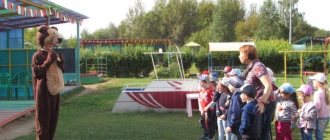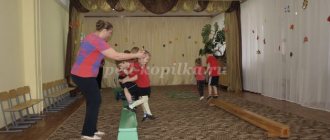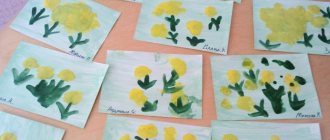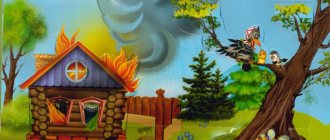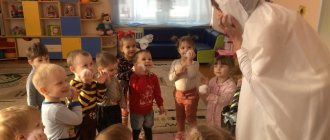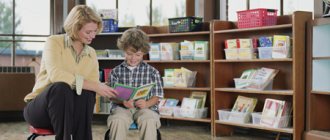Middle group. Junior preschool age. Children 4 - 5 years old
Summary of a music lesson for the middle group “Sounds of Autumn” Synopsis of a music lesson for the middle group “Sounds of Autumn”
To
the music , children run on their toes and form a circle. M.R.: Guys, let's say hello beautifully, in a musical way , sings: Hello, guys.
Children: Hello! M.R.: Guess my riddle: The sun cannot earth... Notes on educational activities in the middle group on the topic “Making noise musical instruments” Notes on direct educational activities in the middle group on the topic: “Making noise musical instruments ”
.
Age of pupils: middle preschool, (5th year of life. Educational areas: “Social and communicative development”
, “Artistic -...
Summary of music lessons in kindergarten for middle group children
Summary of a lesson on artistic and aesthetic development (music) for children in the middle group of kindergarten.
Topic: “Journey to a Fairy Tale” This lesson may be of interest to music directors of kindergartens Purpose: To create conditions for the formation of musical abilities of children of primary preschool age Objectives: to improve singing skills; consolidate skills in playing wooden spoons in an ensemble; to form emotional responsiveness to the music listened to; develop a sense of harmony; develop the ability to perform dance movements related to the text; bring pleasure from collective activities; develop speech Repertoire: Song-chant “Hello, palms” by M. Kartushina “Bus” by S. Zheleznova “Let’s make a circle even” by L. Nekrasov “We live together in kindergarten” by V. Kornikova “Sad mood” by A. Steinville “Bear” by V. Rebikov Materials and equipment: piano, music center, toys - bun, hare, bear, wooden spoons according to the number of children, “bus” - assembled chairs
PROGRESS OF THE LESSON
Children enter the music room accompanied by cheerful music Greeting the Muses of the Hands: Hello, guys! Let's greet each other Song-chant “Hello, palms” Music of hands: Guys, please tell me, do you like fairy tales? Answers from the children of the Muses of Hands: Very good! Today I would like to invite you to visit a fairy tale. Well, the way there is not close, how can we get there? Children offer their own versions of the Music of Hands : Guys, I suggest we all go to a fairy tale together on the bus Children take seats on the bus Musical and rhythmic movements “Bus” Children sit on the bus from chairs and ride to the music, performing movements according to the text of the song Music of the Hands : We've had a blast, and now let's go on foot. Hurry up, guys, get off the bus and look at me! On the right is a friend, on the left is a friend. Everyone quickly stand in a circle. Guess who will appear here now? It was baked from flour and sour cream in a hot oven. He lay on the window and ran away from the house. He is ruddy and round. Who is this? (Kolobok) Well done! And here he is! The Musician of Hands shows the children a toy - Kolobok Kolobok (the toy is voiced by the teacher): Hello, children! Music of hands: Hello, Kolobok. How round and rosy you are. Guys, let's join hands and show how round, even and neat Kolobok is. Children stand in a circle, hold hands, “Let’s make a circle even.” Children perform an exercise based on the lyrics of the song The gingerbread man disappears during the exercise The music of the hands: Guys, where is the kolobok? Where did he go? (looks around) He's nowhere to be found! Let's look for it with our eyes. Gymnastics for the eyes I’ll look to the right, to the left, but I won’t find the bun. No below, and no above. Where are you, Kolobok, Ay!. Music of hands: Well, guys, let's not be upset. Let's sit down on the chairs and wait Listening to “Sad Mood” The Hare of the Muses of Hands appears : Children, who came to us? Children give their answers to the Muses of Hands: What is the bunny’s mood? Children: Sad, sad. Music of hands : Hello Bunny! Have you seen Kolobok? Bunny: I haven’t met Kolobok, and without the game I’m bored. Play with me a little, and then you will go on the road. Music of hands: Guys, let’s do some fun exercises together with the bunny. Hurry up and stand in a circle. Physical exercise: “Jump and jump.” Bunny: Thank you guys, you made me laugh. It's time for me to run, I ran. “Bear” sounds again. Music of hands : Children, who else do you think is coming to us? Children: Bear Muses of Hands: How did you guess? A Bear appears with a basket containing noise instruments. Bear: Hello, children. Children greet the Music of Hands : Tell us, Mishenka, have you met a bun on the road? Bear: I definitely haven’t met Kolobok, because I played with musical instruments. I'm the only one, but there are many tools, and I need help! Music of hands: Guys, let's play on our spoons together with the bear Playing music “Orchestra on Spoons” Children play on spoons to the music Bear: How good you are! Everyone played with all their hearts! It's time for me to go home, goodbye, kids. Music of Hands: We danced with the bunny And we played on spoons with the teddy bear Well, you still haven’t found Kolobok? Suddenly a child's cry is heard in the recording of the Music of Hands: Listen, guys, who is that crying in the corner? Children find Kolobok Kolobok: I'm lost! Music of Hands: You shouldn’t have run away from us, it’s good that we found you, otherwise you would have gotten into trouble again! Kolobok : I won’t run away anymore, I’ll obey! Music of Hands: Guys, let's invite Kolobok to our kindergarten? Children answer the Muses of Hands: Stay with us, little bun, in kindergarten. We have a lot of fun and interesting here. And our song “Kindergarten” : Guys, our journey into a fairy tale has ended, it’s time to go back to kindergarten. Hurry up, take your seats on our bus “Bus” Everyone gets on the bus and returns to the kindergarten Music of the Hands: Our fabulous journey has ended. Let's remember where we went today? Children : In a fairy tale. Music of hands: Who did we meet? Children give answers to the Muses of Hands: What did you do with them? The children answer the Muses of Hands: Well, now it’s time for us to say goodbye. Goodbye guys The children say goodbye and go to the group
We recommend watching:
Summary of a musical GCD in the middle group on the topic: New Year Summary of an open music lesson in the middle group of a kindergarten Rhythmic exercises with sticks for children 4-5 years old Musical lesson for children of the middle group in a kindergarten
Similar articles:
Summary of a music lesson for middle group children
Rhythm lesson for middle and senior kindergarten groups
Summary of music lessons in the middle group
MUSICAL CLASS IN A MIDDLE GROUP on the theme “MATRYOSHKA CAME TO VISIT US”
OBJECTIVES : EDUCATIONAL.
Continue to develop an interest in music and a desire to listen to it. Enrich children's musical experiences. Induce emotional responsiveness when perceiving musical works. Develop expressive singing skills, sing expressively, conveying the character of the song. Develop rhythmic movement skills in accordance with the lyrics of the song. DEVELOPMENTAL. Consolidate knowledge about genres in music (song, dance, march). To develop in children an interest in music and a desire to listen to it. Develop an ear for timbre, purity of intonation, hear the musical introduction and start singing the song after it. Develop the ability to stage a song, develop puppeteering skills. EDUCATIONAL. To develop the culture of listening to music (not to interfere with others listening to a piece to the end). Cultivate politeness in dealing with each other. REPERTOIRE: “Oh, you birch” Russian folk melody, music. didactic game “Recognize by voice” for the development of timbre perception. Song “Rain” music by M. Partskhaladze. dance with nesting dolls music and lyrics by N. Karavaeva MATERIAL AND ATTRIBUTES: Three flat houses of different colors, One large nesting doll, small wooden nesting dolls according to the number of children, mittens - nesting dolls according to the number of children. Disc with a recording of the song “Rain” PREVIOUS WORK, Children are familiar with genres (song, dance, march), games for the development of rhythmic and timbre hearing have been learned, children can perform movements with objects; began to introduce children to staging a song, mastering facial expressions, gestures, and the initial stage of puppeteering. PROGRESS OF THE CLASS. The music director comes to the children's group and tells them that nesting dolls have come to visit the children, they invite the children to play with them. Children enter the music room to the music and stop near the prepared chairs. The teacher draws the children's attention to the nearest house - Mus. ru-l - “A big nesting doll lives in this house, but it will come out to you if you complete the task correctly, what kind of music is this that you will now hear, and what can you do with this music? The Russian folk melody “Oh, you birch” sounds (defining the genre of music and its character). Musical director: “What is the nature of this music? The children answer - cheerful, loud, fast, Musical director: “What can we do to this music?” Children - dance. Musical director: “That’s right, dancing means dancing - cheerful, mischievous, rhythmic. The teacher places a large matryoshka doll in front of the house. Music ru-l: “Guys, let’s play the game “Recognize by Voice.” Let’s show the nesting doll how we can play. Who is our bravest? Come out." The game “Recognize by Voice” is being played to develop timbre perception. During the game, the musical director praises those children who sing the child’s name correctly. Music hand: We showed the nesting doll how we can play, and how can we sing songs? Children - yes! Music hand: I really like the way you sing the song “Rain,” shall we sing it for the matryoshka doll? Children sing the song “Rain” by muses. M. Partskhaladze. The big matryoshka praises the children and sends them to the next house, in which the nesting dolls also live. The children go to the next house. Musical director: “Little wooden nesting dolls live in this beautiful house, do you want to play with them? Children - yes! We invite the children to take a matryoshka doll and divide the children into two groups. Musical director: “Now we’ll see whose matryoshka dolls dance better for girls or boys? Music The hand sets the rhythm for the boys, and the teacher sets the rhythm for the girls. A musical and didactic game “Play Like Me” is conducted to develop rhythmic perception and musical memory. Music The leader evaluates the children's game and offers to place nesting dolls near their house. Musical director: “I invite you, guys, to another house, where nesting dolls also live and they are waiting for you. The children approach the last house. Music hand: “Look, guys, what kind of nesting dolls are waiting for you here.”, (takes out mittens - nesting dolls from the house. - “These nesting dolls want to dance with you.” Educator - “children, you are already familiar with these nesting dolls, we even drew them , Musical instructor: “And today in class we will dance with them, look how we hold the matryoshka doll (showing), look how it will dance on her palm (showing), how the matryoshka waves a handkerchief (showing).” We distribute dolls to the children, we help put it on their hand and offer to make a big circle. The children perform “Dance with Matryoshkas" music by N. Karavaeva. The musical director notes those children who are already good at holding a nesting doll on their hand and notes those children who still need to practice, Music leader - "Children, did you like the nesting dolls? Today you will take them to your group, to your music corner, I really want you to make friends with the nesting dolls (the children say goodbye and leave the hall). FUNNY ARTRYOSHKA.
EDUCATIONAL OBJECTIVES.
Tell children about the organ grinder and organ grinders. Introduce the sound of a toy barrel organ. Develop the ability to have a conversation about music. Develop the concept that a play has its own musical story, which begins with the first bars and ends with the last chord. DEVELOPMENTAL. To develop children's ability to maintain attention throughout the sound of the entire play. Learn the techniques of correct sound production. Learn to play a melody on a metallophone using a triad. To strengthen children's skills in playing together, to develop modal and timbre hearing, a sense of rhythm, and the timbre of various musical instruments. EDUCATIONAL. To develop the culture of listening to music. Cultivate politeness in dealing with each other when choosing musical instruments. REPERTOIRE. Valeological song - chant "Good morning" "Organ Grinder" by P. Tchaikovsky, "Organ Grinder" by D. Shostakovich, Illustrations by artists about organ grinders MATERIAL AND ATTRIBUTES: Portrait of the composer P. Tchaikovsky, musical instruments - metallophones - 5-6 pieces, sticks -10- 12 pieces, 5-6 bells. PREVIOUS WORK. In classes and in groups, we learned to perform familiar chants and individual parts of the play “Hurdy Organ” in small groups and individually, adhere to the general tempo, and simultaneously begin and end the game. PROGRESS OF THE CLASS. Children enter the hall to the music, the teacher offers to say hello with a chant song “Good morning”, then the children sit on the prepared chairs. The music director shows the children a toy barrel organ, how it sounds, then asks: “What fairy tale is written about a barrel organ?” We all remember “Pinocchio” and Papa Carlo together. Next there is a short conversation about the organ grinder. Musical director: Children, what do you think, who is an organ grinder? (children's statements) - Music. ru-l: “An organ grinder is a very poor man who has nothing but an organ grinder. An organ grinder is an ancient mechanical musical instrument that plays a melody when the organ grinder turns the handle. They earned their living by roaming the yards and streets. Now we will look at paintings by artists that depict organ grinders with their instrument - a barrel organ.” When viewing, I give explanations to the pictures: What does the organ grinder look like, what animals help the organ grinder - a monkey, a dog, what kind of music can sound from the organ grinder. Musical director: “We have looked at several films, and now we will listen to the music of P. Tchaikovsky (excerpt) “The Organ Grinder.” I encourage the children to try to guess what this music is talking about. Children can share their guesses after listening. Musical director: “A hurdy-gurdy is not a piano, but a mechanical box in which metal parts move to create a song. The hurdy-gurdy can play one or two very simple melodies. That's why the same song comes out of the barrel organ all the time. Today in class we will try to play the melody of a barrel organ. We have prepared musical instruments for you - metallophones, sticks and bells. Well? Are we turning into musicians? (children's answer). Together with the teacher, we seat the children in groups - children with metallophones, children with sticks, children with bells. First we play all the games separately, and only then all together. At the end of the lesson, I evaluate our orchestra and ask the children whether they liked being musicians. (children’s answer) Musical teacher - “At the next lesson we will try to play other musical instruments. The children leave the hall at a calm pace.
We recommend watching:
Summary of an open music lesson in the senior group Summary of educational activities in music in the middle group “Birds in the Spring” Musical entertainment in the middle group of a preschool educational institution. Scenario Summary of GCD in the middle group on the topic: Funny clowns
Similar articles:
Summary of a thematic music lesson in the senior group “Music Toy Store”
